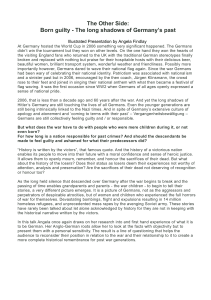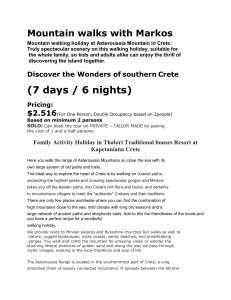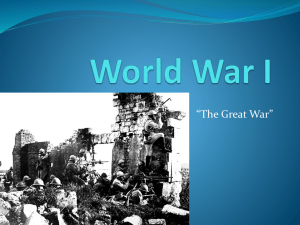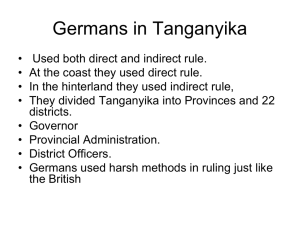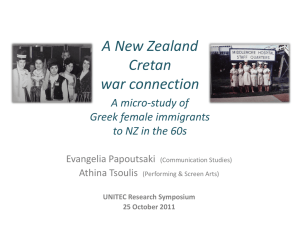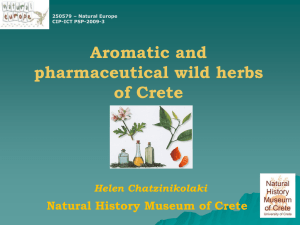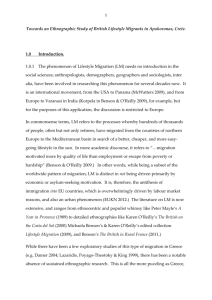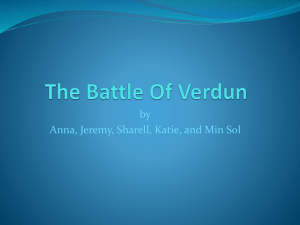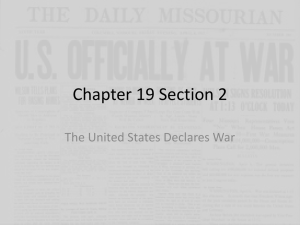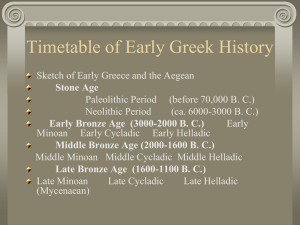Battle of Crete 2
advertisement
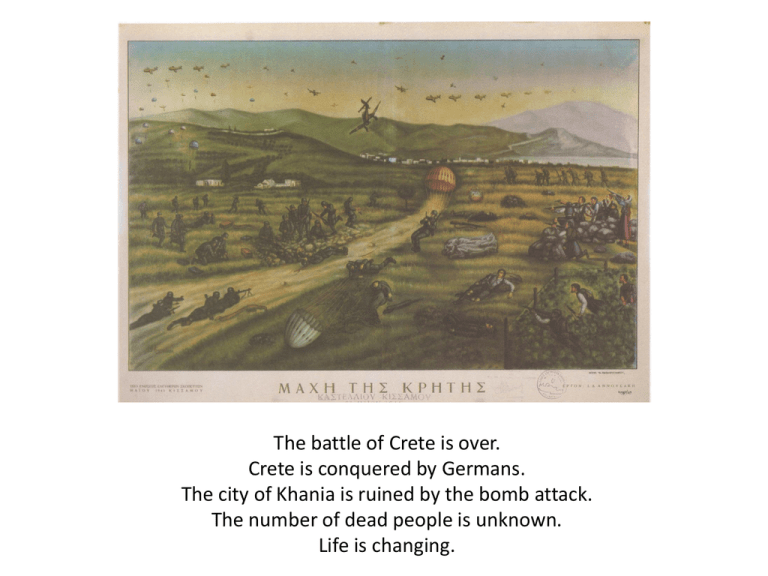
The battle of Crete is over. Crete is conquered by Germans. The city of Khania is ruined by the bomb attack. The number of dead people is unknown. Life is changing. 1941: • Beginning of labour recruitment, retaliations, arrests and executions against Cretan habitants who had fought bravely during the battle of Crete. • Traffic is restricted. Peoples meetings are prohibited. Radio and any means of communication are banned. Any transactions of food and other necessary goods are not allowed. • The above revenge- measures are decided by the Germans and those disobeying them are immediately excecuted. • On the contrary the local authorities of Khania cooperate with the occupants and declare their obedience calling people to accept the new situation and surrender. Resistance organizations Establishing of the first resistance organizations at Crete: • ΕΑΜ(National Liberation Forehead) Νationwide organization of socialist left wing beliefs. • ΕΛΑΣ(Greek Peoples Liberation Army) • ΕΟΚ(National Organization of Crete) local resistance organization involving Cretan and English(allies) people • 1942: The resistance against conquerors is brave. The hard winter and the hanger are unbearable problems. • Also the resistance organize food distribution for supporting and helping people to survive. War-wounded people and kids are queuing to take their own helping. • Compulsory labour for the German army and punishment for everyone who denies to obey: prison and death penalty. • Cretan people fight against the Germans. Not latter than the end of 1941 the first resistant groups appear in the neighbourhoods of Khania and in many villages around. • ΠΟΕΝ(Panhellenic Organization of Free Youth) is founded in Khania, they start action, young peoples voices are heard protesting at nights, calling people to resist against the occupants. • ΠΟΕΝ is attached to ΕΠΟΝ. Picture from resistance February 23rd ,1943: • ΕΠΟΝ (Panhellenic Youth Organisation of ΕΑΜ) is founded. • Demonstrations against peoples recruitment. They protest against Germans decision to get transferred in Germany for work at industry. Greece is the only country where the recruitment is revoked because of ΕΑΜ resistance. • In this proclamation of ΕΠΟΝ the young men and women of Crete urge Cretans to resist against the occupants. Young children resist • These are "aetopoula“(“little eagles”), kids from 812 years old. Their part in resistance is transferring messages and writing political slogans on the walls. These are "saltadoroi" who jump on the German's tipper trunks and steal food supplies. Their contribution is very important. The resistance of the residents had some retaliations. Agia's prison is full of prisoners. AGIA’S PRISON • • • • • Crete’s HELL Every Cretan who is arrested is driven to Agias prison by SS. Over twenty thousand Cretans are inhumanly tortured and more than one thousand are executed there during the German occupation. Life in Agia prison is beyond human mind, it is hell. The Nazi not only do they use burning irons , pincers, needles etc. to torture and humiliate the imprisoned Cretan fighters but they also make virtual executions to make them surrender. Very often they supposedly let them free to shoot them in the back in a few minutes .Before any execution they forced them to dig their own graves. The daily food in prison is just fourty five gramms of flour and a few beans . Not for all of them, those in isolation suffer lack of food and water for months. The exact number of the imprisoned Cretans cannot be verified . According to that time prison’s principal the imprisoned Cretans were more than two thousand. Although the occupants threats , violence and tortures , the Cretans keep fighting for their freedom. ALIKABOS 1941 (a village near Khania) • • As soon as the Germans arrived to the village, either from sky or from land, all the villagers ran to the mountain, holding weapons from their houses which they needed for the upcoming battle. Families were hosted in folds from sheepers and were mostly fed with local plants. Those who had farming animals could also eat meat and milk. Lack of bread , was major such as lack of sugar. Both of them were replaced by St. John’s bread. Every villager worked his farm to earn his living. People, endangering their lives, were informed secretly about the German’s plans from the radio transmitter. Germans used to spend the night to schools , so they were closed and education was prohibited. Despite those, some children attended classes at the church. The families who didn’t flee , were found by the Germans so that men were forced to work for the Germans which usually meant execution. Many of those men pretended to be sick in order to deceive the Germans and escape the labor. Pregnant women were brutally killed. Any mass resistance was bombarded in cold blood. Alikabos was the location of executions for even women and children and all the corpses were covered by branches. Witnessed by Kalaitzaki Evagelia. 1943: Is being fights in the country side between conquerors and resistance teams. Holocaust from conquerors of villages Koustogerako, Livadas, Moni (province of Selino). Holocaust from Greek partnerscooperators of conquerors (Souberites) of village Kallikratis and execution of 29 residents (province of Sfakia). • November 7th, 1943: In the village Therissos of Khania, ΕΑΜ and ΕΟΚ sign a cooperation agreement against German conquerors.
